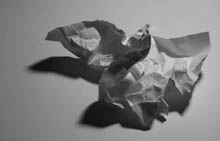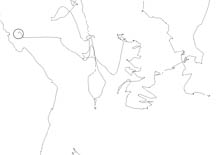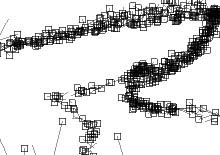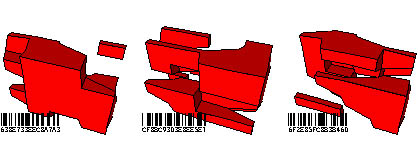 |
[March 23d 2004]

Right: From one of Ole Kristensen's earlier pieces Particles (http://www.ole.kristensen.name/particles).
Computer Code as Art Material
An interview with three artists from the Autopilot exhibition.
Autopilot is an exhibition of generative art in kopenhagenshop as a part of the RADAR festival ( www.visitradar.dk ). The exhibition is curated by kopenhagen.dk/net.art and will take place at kopenhagenshop on Enghave Plads 8 in Vesterbro, April 1st-4th, 2004. The artists are: Pablo Miranda Carranza, Ole Kristensen, Thor Magnusson & Birta Thrastardottir. The opening is April 1 st , 2004, 4 pm- 7 pm. Thomas Petersen asked three of the four artists some questions about the creative process of programming art works and the motivation for constructing generative art systems.
Click here to read the exhibition text for more details about the artists and the individual works.
The works in this exhibition use code as their primary medium/material, which makes the process of programming an interesting focal point for scrutiny. Can you tell me a bit about your experience with programming as an artistic method as opposed to the production of conventional software?
Thor: Yes, for me these (commercial vs. artistic) are two very different ways of working. One is structural, top-down and rigid while the other is associative, bottom-up and loose. When you are working in a group with other people on a commercial product, there is no space to be exploring possibilities and experimenting in the way that an artist can do when programming. Here the structure and functionality of the program is pre-planned from the top down and the programmers follow instructions to make the software. The artist-programmer works in a very different way, I think. One tends to work with a programming language like someone would work with clay. Checking the material, exploring its potential and possibilities and building sketches that lead to something bigger. Commercial software is the opposite: first you've got the project, and then you choose which environment it will be built in and plan the software. The artist, on the other hand, discovers or is exposed to a new programming language, tries it out and works with it on a very basic level. One asks questions like: what can this language do? How can I express myself with it? Is it beautiful and do I like working with it? Is it open source, free and collaborative? Will it survive?
Of course it's not that black and white, as artists can work in a very top-down manner and commercial software is often highly innovative, experimental and ingenious in design. And one must not forget that programming (whether doing commercial or artistic work) is a very creative work where people have to find new and brilliant ways to solve hitherto unsolved problems. I also think that the commercial software companies have always bought up people that are working on innovative and creative software, people that are artists on their own.
 
Left: From Thor Magnusson's & Birta Thrastardottir's Composing Paper (From Autopilot). Right: From ixi-software's Connector (www.ixi-software.net).
Pablo: I think that when talking about programming it is useful to draw analogies with writing in general, of which computer code could be seen as only a particular form (as Kittler explains, a text with the extraordinary capacity of reading and writing itself). There has always existed secular and poetic text, for example, without being anyway easy, as Thor points out in the case of programming, to establish categorical differences between them. As it happens in literary practices with language and text, there is a difference in thinking about code as an end in itself, and code as means for something else. In this last case, code is instrumental, and it does not matter if the goal is a word processing program or an exquisite graphic effect, or the control system for an interactive art installation. In the first case on the other hand, code is not instrumental but it is instead the object of art. Again, in practice there are not clear cut situations, as code can be often both, partly end and partly instrument.
A thing though that I believe that needs to be clarified in this context is the a difference between art and aesthetics; I consider Quick Sort a very beautiful piece of code, in a similar way that I still get amazed when I see proofs of Pythagoras' theorem. Mathematics and sciences in general, as well as technology, are highly aesthetic practices. That does not mean that they are art, or that writing beautiful (and that is another complicated concept) code is an artistic practice. It seems pretty obvious, but more than often the mistake of judging one as the other has been made, and in the blurry field of 'electronic art', the problem remains quite common.
Ole: The first thing that pops into my head is the inability to sketch with code. Being spontaneous and throw stuff around till it looks right. It is hard to code violently. For me, this is one of the key differences to other materials, Of course I can sketch with a pencil and paper before I start coding, but inherent with coding is that you do not see a result until the code actually compiles. This forces you into constant reviewing and looking for errors - and requires a certain logical focus and concentration. It doesn't feel much like screaming, crying, jumping, dancing and laughing.
When it comes to programming for money, I again and again learn that I am bad at it and that I really shouldn't do it. I get to many ideas, and always end up with some beautiful rocket, that people did not ask for. Maybe it does something new, but they do not seem to agree that it is more important than doing what it was told. At best , I make it do what I was told, but in another way than anticipated. This means I usually have to spend a lot of time explaining how and why.
I think one of the strong points of doing software as art is that I can choose not to answer questions or solve problems. I can just make something 'because'.
 
Left: From Ole Kristensen's flyt dig (http://www.ole.kristensen.name/flytdig), a part of the Autopilot exhibition. Right: From Ole's Particles (http://www.ole.kristensen.name/particles).
Whatever a generative system is based on (autonomous algorithms or some sort of input) , there is usually a space wherein multiple potential expressions can arise. Tell me about your motivations for constructing generative art systems as opposed to more static forms of artistic expressions.
Thor: I like to do both, but there is something strangely exciting about creating generative works. First of all, it is less a finished product, less a work of an auteur. It is more of an idea that one creates the genetic structure of, but then it will take on different forms every time it is run. Of course it is one's own creation and one has to take responsibility for it, but it is never the same and one can never know if a particular version of its 'coming-alive' will be interesting or not.
I started writing music and music software in code when I found that commercial software was limiting the way I would work. When one is working with music, and composing it with code, it is very natural to ask oneself: if I can program different sound synthesis, effects and musical structure (or melody) for an instrument, every time the track is listened to, why should I not use that possibility? Music is traditionally a live phenomenon, something that someone has to perform for others to experience, but the invention of recording in the 19th century made it possible to 'grab' the music out of the air, kill it, so to say, and box it in a commercial product, the record. This is new. It is more natural to experience music as something that is alive and subject to change, something that is never played the same way twice, as the situation is never the same.
I find it interesting that we now use the computer as the main creation-, production-, storage-, distribution- and performance-medium of our music and yet we do not use its full potential. I am sure there will be loads of interesting work done in this field in the future, but I don't believe that this format will replace the old linear recording. It is just an addition to an already manifold market of musical expression.

From Pablo Miranda Carranza's ArchiKluge (http://www.armyofclerks.net/ArchiKluge/index.htm) - shown at Autopilot. Also check out: http://www.armyofclerks.net.
Pablo: I myself also got interested in the use of computation as an engine of design when I became aware of the limitations of CAD ( Computer Aided Design - design software, ed.) systems in architecture. The fact is that though ubiquitous, the computer in architecture has mostly implied a very straight forward translation of the drafting board on to a screen. If we think that many of the fundamental definitions of what architecture is, stem from the moment, around the fifteenth century, when architecture begins being projected and drawn, we can understand how the use of algorithms as a form of architectural notation radically challenge the way we think about the discipline. Instead of designing, through generative techniques architects cultivate spaces and designs through generative techniques , in a similar way as the a gardener cultivates plants. This reformulates design as a dialogical process between the medium and the architect, instead of being the drawing of ideas which are projected from the architects mind in to paper, or as it is the case now, into its digital counterpart.
Ole: I think one of the strongest aspects of software art is to do stuff that reacts. I like doing the ant-farmish generative software. However reactive and interactive applications of logic machines are the most fun. Both are ways of performing but I somehow feel that by letting a piece do a more or less straightforward representation of a more or less complex interpretation of input gives you the chance of letting the software or installation be a stage for the spectator to enter. It becomes like a game, where the rules can be more or less set. But you choose to act. Depending on the staging of the object and interaction the spectator becomes a performer. Sometimes it's like building a circle of stone that you have to chosen to step into, at other times it becomes a light playful game. When you look at a piece that samples or interprets you, the uniqueness of your impression is stressed. It is like throwing stones into water just to enjoy the patterns on the surface. The performative software lies in between instrument, stage and canvas.
|
 |
|